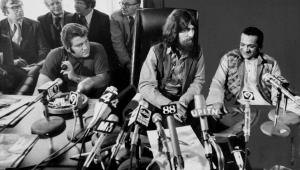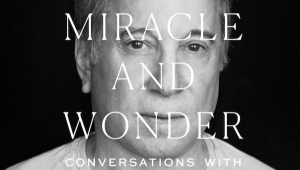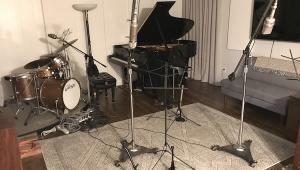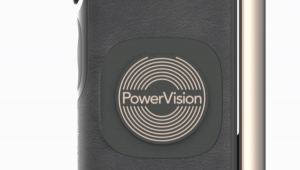Who's Cutting Those Lacquers? Part 2
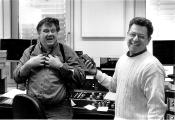
Arriving at the Universal facility in Hanover, I was confronted by a large, multi-storied modern facility. I had been led to believe that the site was the original home of Berliner, but in fact, that was elsewhere in Hanover, and instead a small section of the mastering facility’s first floor had been turned into a small museum showcasing artifacts from among Berliner’s effects. Among them was Berliner’s original flat disc gramophone, early plated lacquers and finished discs, his original “Nipper” drawings, other Berliner designed playback devices, and some photos of the inventors. It was thrilling to see the first flat disc playback device “in the flesh.”
Photos lined the walls and corridors: photos highlighting the rich recording heritage of Deutsche Gramophone and other labels now under the Universal umbrella. There were pictures of recording sessions from the 30’s, 40’s, 50’s and beyond, featuring Herbert Von Karajan conducting the Berlin Philharmonic while a team of recording engineers and technicians in an adjacent control room oversaw the capture to analog tape. There were shots of Karl Bohm, Leonard Bernstein, Seji Osawa, and other luminaries of a bygone era, exuding a gravity, importance and grandeur that people no longer seem to possess anywhere on the planet. That goes for musicians, politicians, you name it. And if you don’t sense it in everyday life, you surely would walking down that corridor taking in those black and white photos.
The contrast between the excitement and vitality of those photos, and the sterile stillness of the cemetery-like Universal vault was stunning as Buskies led me down a corridor littered with analog and digital tape machines to a non-descript door, which, when opened revealed the facility’s sole LP cutting facility—the seeming final living relic of that wonderful bygone era.
Inside, I found veteran LP mastering engineer Mr. Willem Makke in his cluttered but clean cutting room. He greeted me warmly and we began to talk.
MF: You were originally working in Holland?
WM: With several companies including EMI.
MF: You’ve been cutting records for how many years?
WM: About 42, 43 years.
MF: And how long have you been here?
WM: Since 1973.
MF: Are you surprised by this resurgence in analog?
WM: No.
MF: You expected it?
WM: I hoped for it. It is not digital! It is analog. And you have music on the disc and not digital parts. The digital is not complete is it?
MF: And was there a period of time when this mastering suite wasn’t being used at all?
WM: In the ‘90s. Almost no cutting.
MF: And now?
WM: Two or three LPs a week. I can’t do more!
MF: One question I wanted to ask you. A lot of the guys who do what you do, have a personal little scribe on the lead out area. Do you?
WM: No.
MF: It’s not allowed?
WM: It’s not allowed.
MF: Could you put “UMG” (Universal Music Group) on it?
WM: No. Every factory has a number. In Holland it was 670 and here it is 320.
MF: So if it has a 320 on it, it was cut in Hanover? And you’re the only person doing…
WM: No, there are others who have done it…
MF: But for the most part if it’s contemporary if it’s got the 320..and they won’t let you put your little scribe on it?
WM: No! It’s a company policy.
MF: But wait. When Steely Dan"s last album came out, they let Bernie Grundman put his little “BG” on it. Oh, but that’s a Warner Brothers title. Now, since you’ve been doing this, have the lacquers gotten worse?
WM: No. Better.
MF: Who supplies your lacquers?
WM: M-Discs from Japan, We used to use PR, they were the best, but they closed down.
MF: Have you ever ruined a tape.
WM: Yes!
MF: How do feel when that happens?
WM: Well, it’s a problem with the machine when you rewind, then it goes up…that happened in the 1960’s.
MF: And then what happens?
WM: I had good luck. There was a second master!
MF: Back then it wasn’t as tricky, I guess. But now…
WM: I’m careful with tapes.
MF: I’m sure you are!
WM: Now we use reels that don’t do that.
MF: Do you get tapes that are losing the binder and have to be baked?
WM: Yes, sometimes but the older tapes don’t have that problem. BASF had invented a good binder. Then in the 1970’s some companies invented new binders that broke down more quickly but BASF was not allowed to use the binder without paying for the patent so they didn’t, and so they didn’t have the problem, which came around 15 years later.
MF: Did you cut the Mercury Golden Import series that came out of Philips during the 1970’s?
WM: I’d done cuttings for Philips, but I don’t really remember.
MF: These Mercury tapes are in good condition?
WM: Yes.
MF: And how do they sound coming off of that tape recorder?
WM: They certainly don’t sound like recordings of the ‘90’s or today.
MF: Better or worse?
WM: They sound different. They only used a few microphones. Today they use many, (plus) delay microphones…it’s not my...
MF: So you prefer the older recordings?
WM: Yes! They were playing music…the modern recordings are technically perfect, but they have no soul!
MF: Now a machine like that (the Neumann lathe and Ortofon cutter head) is very old.
WM: That was one of the first…bought by DGG in 1979.
MF: And this is a Neumann VMS 80?
WM: Yes and the cutting head is an Ortofon SX-74.
MF: How hard is it to maintain a machine like this?
WM: It’s very difficult. Neumann still exists but Sennheiser only makes microphones and they don’t support it.
MF: And where do you get the cutting styli? Is that a problem?
WM: No. In Japan they build everything! Namiki does it.
MF: You can only do 1/4” tape here?
WM: I can play back and copy from 1/2” but only cut from 1/4.” Some people use digital delay, but I have a preview head so it’s all analog.
MF: So you cut using that machine? How long does it usually take to cut a side to your satisfaction.
WM: One day. Sometimes I hear a recording and I don’t get a good feeling, and perhaps later I feel better.
MF: Now you have EQ here and you will equalize…
WM: I have Neumann equalization, and I used to have Cello which is marvelous, but we no longer have that here.
MF: So they “tolerate” you here, they don’t really support you.
WM: No, not at all. They are supportive as long as...
MF:... they make money from this, then they’ll keep it going.
WM: Of course.
MF: Do you have an apprentice that you’re teaching this to?
WM: No.
MF: Why not?
WM: Young people are not willing to learn the system.
MF: Well what if a young person came here and said “Mr. Makkee, I would like to learn from the master.” Would you teach him?
WM: Of course. But he’d have to learn cutting. It’s not digital.
MF: Of course! But young people are buying records.
WM: Perhaps the company would support this.
MF: They should. Now when you cut a female vocal, do you have a “de-esser?”
WM: Only what’s built into the Ortofon and we’ve rebuilt it to be much better than the original.
MF: And can you punch it in and out?
WM: No. So I set the threshold so it only comes in when needed.
MF: And how often is that?
WM: With analog recordings almost never. With digital the high frequencies are excited with the Aphex exciter and then you have to use it, but that thing is not normal. It’s only used by people using computer studios. They don’t know how to use tape machines anymore!
MF: With these Mercurys you don’t have to use the “de-esser” or anything do you?
WM: No. You just cut it flat! Some parts you need to add or subtract two dB or less.
MF: Do you need to compress?
WM: I don’t compress!
MF: How about bass summing?
WM: Perhaps. But mostly it’s in the recording.
MF: So, you cut a lacquer. Who plates it? The plant that’s going to actually cut the record?
WM: Yes.
MF: It has to be done fast. You use a courier?
WM: Yes. And by the next morning it will be electroplated.
MF: And then you get back a test pressing?
WM: Well normally I cut two or three test lacquers and I listen. It’s not a really good turntable, but it’s okay (the turntable has a Shure V15xMR cartridge).
MF: It’s got a fairly flat response. What speakers are you using?
WM: A Philips motional feedback system.
MF: Is there a subwoofer?
WM: No.
MF: Well, people seem to be very happy with what’s cut here.
WM: Well the titles I do for vinyl are selected!
MF: They’re good to begin with.
WM: Yes.
MF: Now that Lynryd Skynrd is a 1/2” tape?
WM: No. It’s a 1/4” tape.
MF: That came from America?
WM: Yes.
MF: And it’s a Dolby “A” transfer so you have that decoder there.
WM: Yes. We start by playing it and listening with headphones and we make edits, and insert leader tape…
MF: Now who makes the copy of the tape for you? Do you speak with the person making the copy to make sure it’s done correctly?
WM: No. We have a lot of customers, and they send good copies.
MF: Now when they send a digital copy…
WM: No!
MF: Do they ever try to send you an analog tape made from a digital copy? Have you ever caught anyone?
WM: Perhaps The Who (Sell Out). I don’t know. I have perhaps the original here (inaudible) and there are two or three copies…here you can see it is Scotch tape with a 1K tone for alignment? But this is a second tape, and I will compare it with the American tape and another copy here from ‘92 the Dutch used for making music cassettes. Just to compare.
MF: Now the Mercurys, most are in Holland, but some are stored here?
WM: Yes.
MF: And most of the 35MM recordings can’t be used because they are in bad shape?
WM: Yes.
MF: And there’s Respighi’s “The Birds.” That’s a great one! It’s amazing to see that tape! I can’t wait to hear that record when Speakers Corner reissues it! What else is here?
WM: Now the complete Philips classics and of course Deutsche Gramophone
MF: That’s a catalog that can be mined! Now the Warners vinyl reissues are cut here, but I suppose it’s the same process and the same issues, to make sure you get good tapes…
WM: Yes! Here’s a copy of one…
MF: Oh! (Lou Reed and John Cale’s) Songs For Drella!
WM: This is all analog tape. We are not using the digital copy they sent us.
MF: And you can tell by listening that they’ve sent analog.
WM: Yes. It sounds huge. It sounds very good, this, actually. Of course not every tape (song) is on the same level.
MF: So on the fly you have to adjust levels as you’re cutting?
WM: Yes. And no limiters. I don’t like that. It ruins the dynamics. It’s
loud, but it’s not music!
MF: And when you’re done with this tape, you’ll sell this to me?
WM: No no! (everyone laughs)
MF: I’m just kidding.
GB: I send it back to Warners of course!
MF: There you have….
WM: The Who, you were talking about The Who.
MF: There you have multiple copies of “Mary Anne With the Shaky Hands.” Multiple copies.
WM: It’s to make comparisons, to see which is the best.
MF: Now when you take these tapes out and put them up to see whether it might be a digital source, what do you listen for?
WM: You can hear the tape echos, and the start of the track. In analog it’s not possible to make it as exact as in the digital domain. You can’t make the fade in, you can’t do it with analog.
MF: So you’re looking for sonic fingerprints. It’s kind of like a mystery novel. And then you can tell.
WM: Yea, and then I can tell.
MF: And do you make an accusation? Do you call and say “You sent me digital?”
WM: No, no. I say there’s a problem with the tape, can you please take it from the original tape. From the states, I don’t know if they have the original tape or a copy of it. Are the originals staying in England (he was talking about The Who). Does MCA have original tapes or copies, or are the originals in the U.K.? MCA had a special contract with The Who.
MF: Now The Who Sell Out, the original pressing, wasn’t banded. Are you going to cut it that way?
WM: Yes.
MF: Yea, that’s the way to do it I think.
(Here Makkee shows me the ‘dead wax’ on an early German pressing of The Who Sell Out and explains the numbers).
WM: The original tape number is 184 and then 116 is the catalog number of the time and the later one is 2478142. This 2 means the second lacquer and 320 is the plant. And this is the “B” side.
MF: And do you know the numbers of the other plants?
WM: They had plants in England, France, Italy, Spain, South Africa. They could also use metal parts from Germany.
MF: Now if I put ten records on for you, could you tell which were cut using an Ortofon cutter head and which were cut from a Westrex?
WM: You can hear the Westrex only had feedback to around 9K and above that the stylus is uncontrolled. Neumann head had feedback up to around 12K or 13K. The Ortofon goes to 18K.
MF: And you’re cutting RIAA.
WM: Yes. And the Ortofon sounds so smooth!
MF: Now if you’re going to cut mono, would you use a different cutter head?
WM: I know the cutter heads from that time…Ortofon mono cutter head and amplifier.
MF: And none of those exist anymore?
WM: No. The got rid of them.
MF: Might they not be stored somewhere?
WM: No. They had magnets and not coils.
MF: So you’d have to cut with the stereo cutter.
WM: The frequency response of the stereo head is so good compared to the mono head. It is so good, it is better than any cartridge!
MF: I spoke to a cutting engineer from the old Decca days…I forget his name. He said the mono Decca cutter heads were the best in the world.
WM: Well they were built by Decca.
MF: And you couldn’t just stick one of those on there?
WM: No. The whole system is different.
MF: What was the year you cut your first record?
WM: 1958.
MF: You were ten years old?
WM: There was a guy on the corner where I lived who bought his own cutting system. I was playing in this guy’s studio.
MF: Do you remember the first record you cut commercially?
WM: In the ‘60s I started with Philips. We had two cutting machines.
MF: What kind of music do you like?
WM: Jazz and some classical if it’s well played.
MF: Thanks for taking time out of your busy schedule to talk with me.






